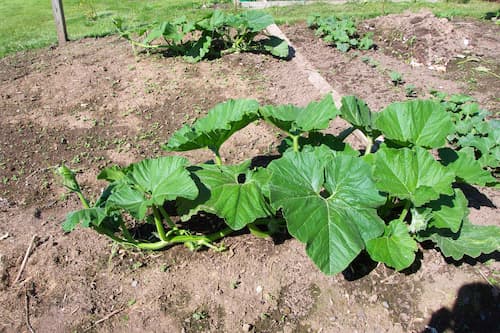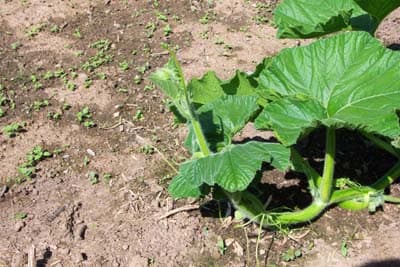
The pumpkin vines are the umbilical cord of the pumpkin plant and fruit. This “lifeline” carries the water and nutrients your plant needs to grow and thrive, and most importantly, bear fruit in mammoth proportions. It is critical that you take good care of the vine and protect it from damage. Described below is the information you need on how to care for pumpkin vines and nurture them to produce bigger, better pumpkins! Then, the vines will help you to have bragging rights in the neighborhood, as your Jack O’Lanterns will be the biggest on the street.
Runners, or secondary vines, proliferate all along the main vine. Secondary vines should be encouraged. But, you need to manage their growth. Along with proper pruning techniques, you should train the vines to grow out and away from the main vine. Also, train them away from the fruit. You do not want the fruit to grow over the runners and cut them off. You also want to be able to get to the fruit to take growth measures, make slight adjustments, to alter it’s position in order to reduce stem stress, and to spray for insects as needed.
Train pumpkin vines to grow straight out from the planting site. Avoid crossing the runners, as this creates overcrowding and allows for better access to the plant for maintenance.
Tertiary vines grow off the secondary vines. We recommend pruning these, to promote growth to the fruit, versus plant growth.
Secondary roots develop on the vine at the base of each leaf stem. Encourage this as much as possible. This is accomplished, by assuring that the vine comes in contact with the ground. You can also cover the vines at the root nodes with rich garden soil. The secondary roots can add enormous weight to your fruit. A second benefit of secondary roots, is that it anchors the plant in the ground along the entire vine system and allows the plant to better withstand windstorms. Keep secondary roots from growing near your fruit, as this causes the vine to be anchored to the ground and unable to move with the growth of your fruit. This can cause stem stress and splitting.
Ideally, you want your plant to develop a strong support system for the best growth of your fruit. At the same time, you do not want them to grow rampant all over your field or your lawn. Likewise, you do not want them to cross over each other. Proper spacing of the plants is the first step in this process. Training the vines to grow in the direction you intend for them to go is another important step. At a certain point, you should plan to prune the vines to stop their growth. Not only will pruning allow better management of your crop, but it will also encourage the plant to devote its energies towards fruit growth.
Main vines should be pruned when they reach ten to fifteen feet beyond the last fruit you are leaving on the plant.
Secondary vines(or runners) should be trimmed when they reach ten to twelve feet from the main vine.
Trimming a vine is simple. Cut the vine at the end and bury the end by placing a shovelful or two of soil over the cut end. Burying the vine is recommended, but not essential. It will minimize moisture loss while the cut is fresh and minimize the possibility of disease entering through the wound.
After pruning the vines, you will likely experience a proliferation of new vines. There will be new runners off the main vine and new runners on the runners. This is similar to when you trim a bush or hedge row. The result is a bushier, healthier plant. Pruning is good for any and all plants. In the case of pumpkins, continue to pinch off any new growth beyond the limits recommended above. I will allow some small additional growth, largely because it is almost impossible to keep up. After a while, the plant will turn it’s energy towards fruit growth. A little extra potassium and a little less nitrogen will further encourage the fruit growth, as opposed to vine and leaf growth.
If you don’t trim the vines, you have not harmed the overall health of your plant. But, you are not doing anything to enhance fruit growth. In addition, your patch will look unruly. I once let a giant pumpkin vine grow as long as it could just to experiment and to see how long it could grow. I gave up at thirty feet. What I found, was the end of the vine was being starved. It’s support system could not keep up and the fruit on it at ten feet was sucking up most of the nutrients. I am sure if I had no fruit on the vine and had more actively pursued secondary root growth, I could have coaxed it much further. Sanity finally returned and I terminated the end to force the plant’s energy to the fruit.
Yes, cover your vines with soil. This will promote secondary root growth if you leave the soil moist. Covering the vines can also cut down on th insect damage. The disadvantage to this method is you do not know what is going on below the surface. But, the advantage far exceeds the risk.
Some growers recommend soil from the surrounding area. When I have the time, I like to mix well composted materials, including my favorite “black gold” (leaf mulch from our town’s recycling center) and some garden soil. Bottom line here is every grower had their own formula.
This is one of the more time consuming activities and definitely little fun. But, the payback in secondary root growth and therefore bigger pumpkins is well worth the effort.
Your vine does have at least one mortal enemy. The dreaded(and I am serious) Vine Borer is perhaps the biggest worry to pumpkin growers and can end a promising season in a real hurry. For information on this and other insects surf on over to Those Pesky Bugs.
The vine of a pumpkin plant are not susceptible to many diseases. The leaves however are far more susceptible. Any diseases that can harm the vine part of the plant will destroy the leaves first. Plant disease information can be found at Diseases and Bacterias.

It is not uncommon, to see a fast growing vine, begin to curl upward at the growing tip (the end of the vine). Usually, the vine will “lay down” over a period of time. However, if the vine curl results in several inches, or even a foot or more of curl, the growing tip is susceptible to breaking. This can happen due to a high wind, or the sheer weigh of the vine that is off the ground. A broken growing tip, can delay fruit set be week or more.
We recommend that you provide some support under the vine to minimize the risk. Take a small barrel or a five gallon bucket. Place it on its’ side under the end of the vine. Each day, you need to very carefully move the barrel out to compensate for the new growth of vine. With this effort, there is the risk that you can break the vine in handling it. So, I will repeat…… be VERY CAREFUL when handling the vines.


